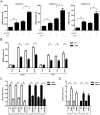Quantitative Proteomic Profiling Identifies SOX8 as Novel Regulator of Drug Resistance in Gestational Trophoblastic Neoplasia
- PMID: 32411596
- PMCID: PMC7198745
- DOI: 10.3389/fonc.2020.00557
Quantitative Proteomic Profiling Identifies SOX8 as Novel Regulator of Drug Resistance in Gestational Trophoblastic Neoplasia
Abstract
The development of drug resistance remains one of the major challenges to current chemotherapeutic regimens in gestational trophoblastic neoplasia (GTN). Further understanding on the mechanisms of drug resistance would help to develop more effective therapy to treat GTN. Herein, tandem mass tag-based (TMT) quantitative proteomic technique was used to establish drug resistance-related proteomic profiles in chemoresistant GTN cell models (JEG3/MTX, JEG3/VP16, JEG3/5-Fu). In total, we identified 5,704 protein groups, among which 4,997 proteins were quantified in JEG3 and its chemoresistant sublines. Bioinformatics analysis revealed that multiple biological processes/molecular pathways/signaling networks were involved in the regulation of drug resistance in chemoresistant JEG3 sublines. SOX8 was upregulated in all the three chemoresistant sublines, and its function was further investigated. Knockdown of SOX8 significantly reduced cell viability, impaired soft agar clonogenesis, and increased caspase-3 activities after drug treatment in JEG3 chemoresistant sublines. In addition, over-expression of SOX8 promoted cell survival, enhanced soft agar clonogenesis, and attenuated caspase-3 activities after drug treatment in GTN cells. Importantly, SOX8 might be a potential regulator of reactive oxygen species (ROS) homeostasis, as SOX8 regulated the expression of antioxidant enzymes (GPX1, HMOX1) and reduced drug-induced ROS accumulation in GTN cell models. Collectively, SOX8 might promote drug resistance through attenuating the accumulation of ROS induced by chemotherapeutic drugs in GTN cells. Targeting SOX8 might be useful to sensitize GTN cells to chemotherapy.
Keywords: SOX8; drug resistance; gestational trophoblastic neoplasia; quantitative proteomics; reactive oxygen species.
Copyright © 2020 Jun, Peng, Zhang and Shi.
Figures








Similar articles
-
Activation of RSK2 upregulates SOX8 to promote methotrexate resistance in gestational trophoblastic neoplasia.Lab Invest. 2021 Nov;101(11):1494-1504. doi: 10.1038/s41374-021-00651-0. Epub 2021 Aug 9. Lab Invest. 2021. PMID: 34373588
-
Quantitative proteomic analysis identifies novel regulators of methotrexate resistance in choriocarcinoma.Gynecol Oncol. 2020 Apr;157(1):268-279. doi: 10.1016/j.ygyno.2020.01.013. Epub 2020 Jan 17. Gynecol Oncol. 2020. PMID: 31955862
-
DPP4 Regulates DHCR24-Mediated Cholesterol Biosynthesis to Promote Methotrexate Resistance in Gestational Trophoblastic Neoplastic Cells.Front Oncol. 2021 Dec 2;11:704024. doi: 10.3389/fonc.2021.704024. eCollection 2021. Front Oncol. 2021. PMID: 34926239 Free PMC article.
-
Genetics of gestational trophoblastic neoplasia: an update for the clinician.Future Oncol. 2010 Dec;6(12):1915-23. doi: 10.2217/fon.10.153. Future Oncol. 2010. PMID: 21142864 Review.
-
Gestational trophoblastic neoplasia.Semin Oncol Nurs. 1990 Aug;6(3):228-36. doi: 10.1016/0749-2081(90)90007-r. Semin Oncol Nurs. 1990. PMID: 2169068 Review.
Cited by
-
Lectin galactoside-binding soluble 3 binding protein mediates methotrexate resistance in choriocarcinoma cell lines.Bioengineered. 2022 Feb;13(2):2076-2086. doi: 10.1080/21655979.2021.2022844. Bioengineered. 2022. PMID: 35038949 Free PMC article.
-
SOX8 Affects Tumoral SPARC Expression by Regulating EZH2 to Attenuate Effectiveness of albumin-bound paclitaxel in PDAC.Int J Biol Sci. 2022 Jan 1;18(3):911-922. doi: 10.7150/ijbs.64752. eCollection 2022. Int J Biol Sci. 2022. PMID: 35173526 Free PMC article.
-
SLAMF1 Promotes Methotrexate Resistance via Activating Autophagy in Choriocarcinoma Cells.Cancer Manag Res. 2020 Dec 30;12:13427-13436. doi: 10.2147/CMAR.S278012. eCollection 2020. Cancer Manag Res. 2020. PMID: 33408515 Free PMC article.
References
-
- Maestá I, Nitecki R, Horowitz NS, Goldstein DP, de Freitas Segalla Moreira M, Elias KM, et al. . Effectiveness and toxicity of first-line methotrexate chemotherapy in low-risk postmolar gestational trophoblastic neoplasia: the new England trophoblastic disease center experience. Gynecol Oncol. (2018) 148:161–7. 10.1016/j.ygyno.2017.10.028 - DOI - PubMed
LinkOut - more resources
Full Text Sources
Research Materials
Miscellaneous

